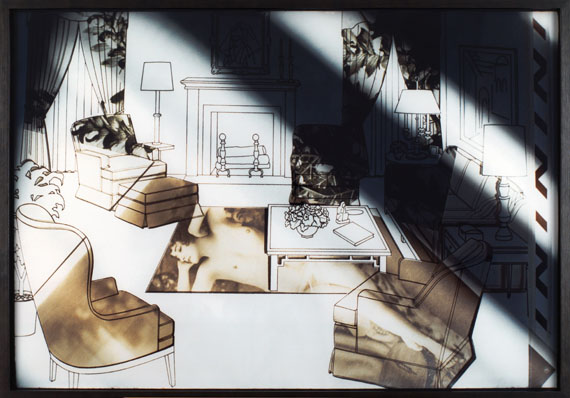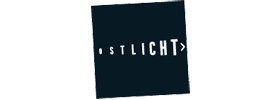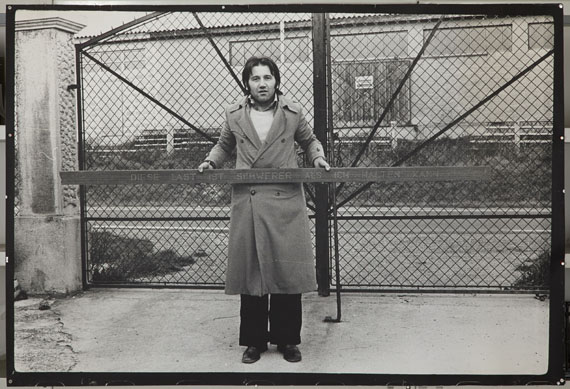
2D23D
photography as sculpture / sculpture as photography
Will Benedict » Clegg & Guttmann » Kerstin Cmelka » VALIE EXPORT » Michael Hakimi » Michael Höpfner » Birgit Jürgenssen » Sonia Leimer » Christian Mayer » Friederike Pezold » Alfons Schilling » Nora Schultz » Nadim Vardag » Peter Weibel » Heimo Zobernig »
Exhibition: 4 Oct – 26 Nov 2014
Fri 3 Oct 19:00
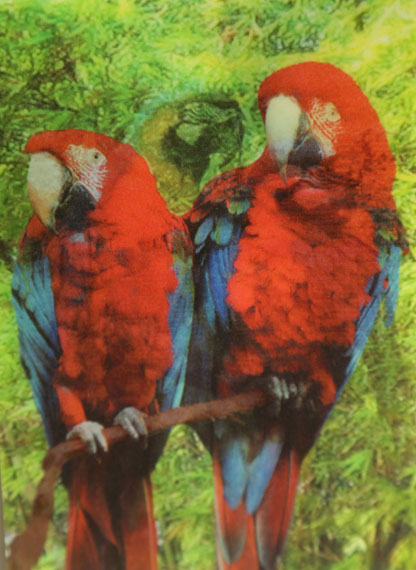
"2D23D.
photography as sculpture / sculpture as photography"
Exhibition: 4 October – 26 November 2014
Opening: 3 October, 7 pm
Speakers: Rebekka Reuter, Martin Guttmann and Peter Weibel
From two- to three-dimensionality, between photography and sculpture: Galerie OstLicht takes the medium of photography out of its frame and expands it into space. Classic pieces of photo and media art meet new works, some of which have been developed specifically for this exhibition. With a special focus on Vienna 2D23D. photography as sculpture / sculpture as photography presents artistic positions from the late 1960s to the present that enter into a dialogue and examine the interaction of a photographic approach with sculptural and spatial aspects. Highly idiosyncratic and prominent in terms of content and aesthetics, they share a feature in spite of all differences: they are reflections of human perception and how it is conveyed in various media, which they explore, exaggerate, thwart and undermine. Conceptual media analysis, performative staging of the self, photographic gesture or complex interwoven spaces – all chosen photographic objects, video sculptures and room installations present the process of pictures taking shape and introduce a perspective that might be regarded as a new, three-dimensional collage.
Will Benedict (b. 1978) equally makes use of painting and photography in his work. In Untitled (2014) he also includes three-dimensional objects – a table, two chairs and two monitors – which imbue the piece with a sculptural identity. The assemblage of objects creates the atmosphere of a living room or a workplace, which provides a new context for Benedict’s two-dimensional work.
In their Ideational Constructs (2003) Clegg & Guttmann (Michael Clegg: b. 1957, Martin Guttmann: b. 1957) take the principle of collage and expand it into the third dimension. They combine photographic fragments of the faces of various post-war intellectuals and the artists themselves to create bizarre portraits on pedestals, appropriating space and presenting a sculptural criticism of ideology.
The video piece The Individualists (2012) features three re-enactments of historical TV interviews, e.g. between Bianca Jagger and Steven Spielberg in 1979. The microdramas by Kerstin Cmelka (b. 1974), performed on raised pedestals made of rubble, expose the absurdity and clichés of her templates.
VALIE EXPORT (b. 1940) is represented with two photos of her Handkonfigurationen [Hand Configurations] (1973) and with the piece Nachfügung [Compliance] (1974) from her series Körperkonfigurationen [Body Configurations]. The latter, which show the body of the media artist configured with its environment, have become classic pieces of feminist-actionist criticism of the standardised image of the body.
In addition to his sculpture Untitled (Großer Phönix I) [Untitled (Large Phoenix I)] (2013), which creates interwoven space, Michael Hakimi (b. 1968) presents the installation Koordinaten [Coordinates] (2007/2014) in the gallery: double pages from daily newspapers unfold from a corner like vectors along the three axes of the room, exposing the conditions of space and therefore at the same time of its own existence.
Outpost of Progress (2011) is the result of Michael Höpfner’s (b. 1972) eight-week hiking tour on the high plateau Chang Tang in West Tibet. The installation, consisting of light boxes, slides and essential residence modules as an expression of individual freedom and cultural analysis, contradicts both the logics of capitalism and the idealisation of nature.
In her photo series Interieurs (1996-98) Brigit Jürgenssen (1949-2003) deals with the relation of sexuality/gender and space. Her adaptations of architectural designs from an issue of the magazine “Homes & Gardens” use reflections of light and montage to create irritating disruptions of the usual labels associated with the “house-wife”.
The concept of the work Ohne Titel [Untitled] (2014) by Sonia Leimer (b. 1977) appears related to the medium of photography and its genuine characteristic of fragmenting space and time. It is a piece of asphalt: found, removed and framed – a trivial fragment of urban space that embodies history, remembrance and meaning.
Christian Mayer (b. 1976) has developed his installation Threshold and Inertia (2014) in reference to Anselm Adams’s legendary Polaroid film tests. Seven Polaroid type 55 pictures are presented on the exhibition wall opposite their negatives that are fixed to banana plants. On the leaves of the plants the motifs take shape with the help of photosynthesis.
Die neue leibhaftige Zeichensprache [The New Embodied Sign Language] (1973-1977) by Friederike Pezold (b. 1945) – her famous, cross-media work – is presented as a four-part column of monitors: Augenwerk, Mundwerk, Brustwerk and Schamwerk feature a body region each (the artist’s eyes, mouth, breasts and genitals, respectively), moving slowly, in a reduced, abstract way, beyond voyeuristic projection.
Alfons Schilling (1934-2013) based his lenticular work Chicago 1968 (1969) on photos he had taken during the riots in connection with the Democratic Convention in late August. In this work, issues of perspective and the view of the world, which the artist explored in his stereo images and “viewing machines”, are also strongly evident on the level of content.
Nora Schultz (b. 1975) reverses the exhibition title by converting a postcard with a lenticular image into a two-dimensional photograph. Parrots (2007/2014) captures the moment when the images of two colourful pairs of parrots are about to change and is based on the artist’s occupation with aspects of space, reproduction and language.
The photograph Untitled (2014) by Nadim Vardag (b. 1980) reflects a specific situation regarding light and space of Galerie OstLicht. Viewed on the spot an irritating overlapping of photographic image and “real” reflection manifests itself which questions the mechanisms of perception, visualisation and display.
Diese Last ist schwerer als ich halten kann [This Load Is Heavier Than I Can Bear] (1975) is a key work of Peter Weibel’s (b. 1944) conceptual art. By combining two large-format black-and-white photos and a stick of stone that is used as a yardstick he shows that photography is open to interpretation, that truthfulness depends on the context and that even statements on gravity are relative.
Heimo Zobernig (b. 1958) created ohne Titel [untitled], 1986/2014 (2014) specifically for this exhibition as a variation of an earlier work, which had been inspired by the design of a tram stop close to the Vienna State Opera. The cardboard sculpture, featuring photo prints and black synthetic lacquer, also reflects the possible failure of the relation of photography and sculpture.
The exhibition is accompanied by a catalogue published by Verlag für moderne Kunst ((136 pages, English/German, price: € 22).�

"2D23D.
photography as sculpture / sculpture as photography"
Ausstellung: 4. Oktober bis 26. November 2014
Eröffnung: Freitag, 3. Oktober, 19 Uhr
Es sprechen Martin Guttmann, Rebekka Reuter und Peter Weibel.
Von der Zwei- in die Dreidimensionalität, zwischen Fotografie und Skulptur: Die Galerie OstLicht lässt das Medium Fotografie aus dem Rahmen und in den Raum treten.
Dabei treffen Klassiker der Foto- und Medienkunst auf neue, teils eigens für die Ausstellung konzipierte Werke. Mit einem speziellen Fokus auf Wien präsentiert 2D23D. photography as sculpture / sculpture as photography künstlerische Positionen von den späten 1960er-Jahren bis heute, die das Fotografische im Zusammenspiel mit skulpturalen und räumlichen Facetten verhandeln. Bei aller Differenz, thematisch wie ästhetisch höchst eigen und prominent, eint sie eine Reflexion der menschlichen Wahrnehmung und ihrer medialen Vermittlung, die sie ausloten, übertreiben, durchkreuzen und unterlaufen. Ob als konzeptuelle Medienanalyse, performative Selbstinszenierung, fotografische Geste oder komplexe Raumverschränkung – die ausgewählten Foto-Objekte, Video-Skulpturen und Raum-Installationen stellen den Prozess des Bildwerdens aus und eröffnen eine Perspektive, die sich als neue, als dreidimensionale Collage fassen lässt.
Will Benedict (* 1978) bedient sich in seinen Arbeiten sowohl der Malerei als auch der Fotografie. In Untitled (2013) inkludiert er nun auch dreidimensionale Objekte – einen Tisch, zwei Stühle und zwei Monitore – die der Arbeit eine skulpturale Identität verleihen. Die Assemblage von Objekten schafft eine Wohnzimmer oder Arbeitsplatzatmosphäre, die Benedicts zweidimensionales Werk in einen neuen Kontext stellt.
Mit ihren Ideational Constructs (2003) überführen Clegg & Guttmann (Michael Clegg *1957, Martin Guttmann *1957) das Prinzip der Collage in die Dreidimensionalität. Fotografische Gesichtsfragmente diverser Nachkriegsintellektueller und des Künstlerduos selbst sind zu bizarren Porträts auf Sockeln vereint, die als skulpturale Ideologiekritik den Raum besetzen.
Die Videoarbeit The Individualists (2012) besteht aus drei Re-Inszenierungen von historischen Fernsehinterviews, etwa zwischen Bianca Jagger und Steven Spielberg 1979. Überhöht auf Sockeln aus vorgefundenem Bauschutt, legen die Mikrodramen von Kerstin Cmelka (*1974) das Absurde und Schablonenhafte ihrer Vorlagen frei.
VALIE EXPORT (*1940) ist mit vier Fotografien ihrer Körperkonfigurationen vertreten: Auflegung (1972), Einschluss (1972), Nachfügung (1974) und Verletzungen (1972) zeigen den Körper der Medienkünstlerin in spezifischen Anpassungen an seinen Umgebungsraum und sind zu Klassikern feministisch-aktionistischer Kritik an normierten Körperbildern avanciert.
Neben seiner raumverschränkenden Skulptur Untitled (Großer Phönix I) (2013) installiert Michael Hakimi (*1968) Koordinaten (2014) in der Galerie: Doppelseiten aus Tageszeitungen entfalten sich vektorenhaft von einer Ecke in die drei Achsen des Raums, dessen Bedingungen damit ebenso exponiert werden wie jene der eigenen Existenz.
Outpost of Progress (2011) ist das Ergebnis einer achtwöchigen Wanderung Michael Höpfners (*1972) über das Hochplateau des Chang Tang im westlichen Tibet. Die Installation aus Leuchtkästen, Dias und angedeuteten Zeltkonstruktionen als Ausdruck individueller Freiheit und kultureller Analyse widerspricht Logiken des Kapitalismus ebenso wie Idealisierungen von Natur.
Mit der fotografischen Serie der Interieurs (1996-98) widmet sich Brigit Jürgenssen (1949 – 2003) dem Verhältnis von Sexualität/Geschlecht und Raum. Ihre Bearbeitung von Architekturentwürfen aus einem „Schöner Wohnen“-Magazin mittels Lichtreflexen und Montage sorgt für irritierende Brüche in gängigen Etikettierungen der "Haus-Frau".
Konzeptuell verwandt mit dem Medium Fotografie, seiner genuinen Eigenschaft des Fragmentierens von Zeit und Raum, erscheint die Arbeit Ohne Titel (2014) von Sonia Leimer (*1977). Es ist ein Stück Asphalt: gefunden, enthoben und gerahmt – ein banales Fragment des urbanen Umfelds, das Geschichte, Erinnerung und Bedeutung verkörpert.
In Referenz zu den legendären Polaroid-Filmtests von Anselm Adams hat Christian Mayer (*1976) die Installation Threshold and Inertia (2014) entwickelt. Sieben Sofortbildern des Typs 55 an der Ausstellungswand sind ihre Negative im Raum gegenübergestellt, fixiert an Bananenpflanzen, auf deren Blättern sich mittels Fotosynthese die Motive realisieren.
Die neue leibhaftige Zeichensprache (1973-1977) von Friederike Pezold (*1945) – ihr berühmtes, medienübergreifendes Werk – wird als vierteilige Monitorsäule präsentiert: Augenwerk, Mundwerk, Brustwerk und Schamwerk zeigen die jeweiligen Körperregionen der Künstlerin in langsamer Bewegung, reduziert, abstrakt, jenseits voyeuristischer Projektionen.
Der Linsenrasterarbeit Chicago 1968 (1969) liegen Aufnahmen zugrunde, die Alfons Schilling (*1934) bei den Straßenunruhen anlässlich des Parteikonvents der Demokraten Ende August fotografierte. Fragen der Perspektive und Weltanschauung, die der Künstler mit seinen Raumbildverfahren und Sehmaschinen untersuchte, sind hier also auch inhaltlich virulent.
Nora Schultz (*1975) kehrt den Ausstellungtitel um und bannt eine Wackelbild-Postkarte in fotografische Flächigkeit: 3-d Parrots (2009) zeigt den Kippmoment zwischen zwei Bildern farbenprächtiger Papageienpaare, der einer konsequenten Auseinandersetzung der Künstlerin mit Aspekten von Raum, Reproduktion und Sprache entspringt.
Die Fotografie Untitled (2014) von Nadim Vardag (*1980) spiegelt eine spezifische Licht- und Raumsituation der Galerie OstLicht wider. In der Betrachtung vor Ort entsteht eine irritierende Überlagerung von fotografischem Abbild und „realer“ Reflexion, die Mechanismen der Wahrnehmung, der Sichtbarmachung und des Displays hinterfragt.
Diese Last ist schwerer als ich halten kann (1975), ein Schlüsselwerk der Konzeptkunst von Peter Weibel (*1944), führt in der Kombination zweier großformatiger Schwarzweiß-Fotografien und einem "Stein-stab" als "Maß-stab" vor Augen, dass Fotografien bedeutungsoffen, Wahrheitsgehalte kontextabhängig und selbst Aussagen über die Schwerkraft relativ sind.
Heimo Zobernig (*1958) hat ohne Titel, 1986/2014 (2014) speziell für die Ausstellung als Variation einer früheren Arbeit realisiert, die von einer Haltestellenarchitektur an der Wiener Staatsoper inspiriert war. Die mit fotografischen Abzügen und schwarzem Kunstlack versehene Kartonskulptur reflektiert auch das mögliche Scheitern der Beziehung von Fotografie und Skulptur.
Begleitend zur Ausstellung erscheint ein Katalog im Verlag für moderne Kunst.�
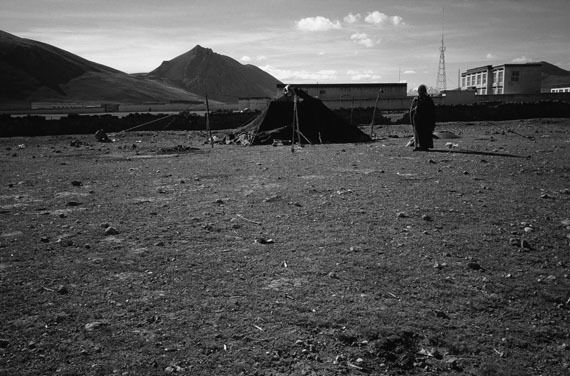
Courtesy Galerie Hubert Winter © Michael Höpfner
